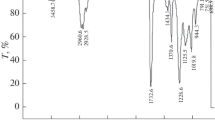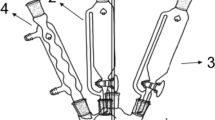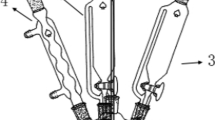Abstract
A series of cationic polyurethane-fluorinated acrylic hybrid latex (PUFA) have been synthesized by solvent-free method. In the method, vinyl monomers acted as dilution agent and the polyurethane (PU) having quaternary ammonium groups acted as macromolecular emulsifier without using any other solvent and surfactant. The structure and properties of PUFA were characterized by Fourier transform infrared spectroscopy (FT-IR), F19 nuclear magnetic resonance (F19 NMR), particle size distribution (PSD) analysis, transmission electron microscopy (TEM), contact angle (CA), surface free energy analysis, scanning electron microscope (SEM) equipped with energy dispersive X-ray spectrometry (EDS), and thermogravimetric (TG) analysis. The FT-IR, F19 NMR, and EDS confirmed that the FA monomer had been introduced into the chain of the PUFA hybrid polymer. The PSD analysis indicated the particles of PUFA were smaller than corresponding pure PU dispersion and narrower in particle size distribution. The CA and surface free energy analysis proved the PUFA hybrid latex film with fluorine possessed higher contact angle and lower surface free energy in contrast with the film without fluorine. The FPUA films exhibited good surface property which could be enhanced at higher annealing temperature. The EDS of PUFA confirmed the fluorine enrichment on the surface of PUFA. TG analysis suggested the PUFA hybrid latex film had a better thermal stability than pure PU.








Similar content being viewed by others
References
Liu S-G, Zhu G-Q (2007) Effects of altered reaction conditions on the synthesis of polyurethane-poly(2,2,2-trifluoroethyl methacrylate) triblock copolymer aqueous dispersion. Eur Polym J 43:3904–3911
Mohaghegh SMS, Barikani M, Entezami AA (2006) The effect of grafted poly(ethylene glycol monomethyl ether) on particle size and viscosity of aqueous polyurethane dispersions. Colloid Surf A 276:95–99
Nanda AK, Wicks DA (2006) The influence of the ionic concentration, concentration of the polymer, degree of neutralization and chain extension on aqueous polyurethane dispersions prepared by the acetone process. Polymer 47:1805–1811
Brown RA, Coogan RG, Fortier DG et al (2005) Comparing and contrasting the properties of urethane/acrylic hybrids with those of corresponding blends of urethane dispersions and acrylic emulsions. Prog Org Coat 52:73–84
Subramani S, Park Y-J, Lee Y-S et al (2003) New development of polyurethane dispersion derived from blocked aromatic diisocyanate. Prog Org Coat 48:71–79
Raghu AV, Lee YR, Jeong HM et al (2008) Preparation and physical properties of waterborne polyurethane/functionalized graphene sheet nanocomposites. Macromol Chem Phys 209:2487–2493
Lee YR, Raghu AV, Jeong HM et al (2009) Properties of waterborne polyurethane/functionalized graphene sheet nanocomposites prepared by an in situ method. Macromol Chem Phys 210:1247–1254
Nguyen DA, Lee YR, Raghu AV et al (2009) Morphological and physical properties of a thermoplastic polyurethane reinforced with functionalized graphene sheet. Polym Int 58:412–417
Sundar S, Vijayalakshmi N, Gupta S et al (2006) Aqueous dispersions of polyurethane–polyvinyl pyridine cationomers and their application as binder in base coat for leather finishing. Prog Org Coat 56:178–184
Kim YB, Kim HK, Yoo JK et al (2002) UV-curable polyurethane dispersion for cationic electrodeposition coating. Surf Coat Technol 157:40–46
Erol I (2008) Novel methacrylate copolymers with fluorine containing: synthesis, characterization, reactivity ratios, thermal properties and biological activity. J Fluorine Chem 129:613–620
Cui X-J, Zhong S-L, Gao Y et al (2008) Preparation and characterization of emulsifier-free core–shell interpenetrating polymer network-fluorinated polyacrylate latex particles. Colloids Surf A 324:14–21
Qu A-L, Web X-F, Pi P-H et al (2009) Gradient distribution of fluorine on the film surface of the organic–inorganic hybrid fluoropolymer. Colloids Surf A 345:18–25
Kim BG, Sohn E-H, Cho K et al (2008) Semifluorinated side group poly(oxyethylene) derivatives having extremely low surface energy: synthesis, characterization, and surface properties. Eur Polym J 44:2912–2919
Chen Y-J, Zhang C-C, Chen X-X (2006) Emulsifier-free latex of fluorinated acrylate copolymer. Eur Polym J 42:694–701
Xiao X-Y, Wang Y (2009) Emulsion copolymerization of fluorinated acrylate in the presence of a polymerizable emulsifier. Colloids Surf A 348:151–156
Zhang Q-H, Luo Z-H, Zhan X-L et al (2009) Monomer reactivity ratios for fluoroacrylate and butyl methacrylate in miniemulsion copolymerizations initiated by potassium persulphate. Chin Chem Lett 20:478–482
Saïdi S, Guittard F, Guimon C (2006) Synthesis and characterization of copolymers based on styrene and partially fluorinated acrylates. Eur Polym J 42:702–710
Cui X-C, Zhong S-L, Wang H-Y (2007) Synthesis and characterization of emulsifier-free core–shell fluorine-containing polyacrylate latex. Colloids Surf A 303:173–178
Li H, Zhang Z-B, Hu C-P et al (2004) Surface composition and property of film prepared with aqueous dispersion of polyurethaneurea-acrylate including fluorinated block copolymer. Eur Polym J 40:2195–2201
Tanaka H, Suzuki Y, Yoshino F (1999) Synthesis and coating application of waterborne fluoroacrylic-polyurethane composite dispersions. Colloid Surf A 153:597–601
Zhang C-Y, Zhang X-Y, Dai J-B et al (2008) Synthesis and properties of PDMS modified waterborne polyurethane–acrylic hybrid emulsion by solvent-free method. Prog Org Coat 63:238–244
Owens DK, Wendt RC (1969) Estimation of the surface free energy of polymers. J Appl Polym Sci 13:1741–1747
Fowkes FM (1964) Attractive forces at interfaces. Ind Eng Chem Res 56:40–52
Cheng X-L, Chen Z-X, Shi T-S et al (2007) Synthesis and characterization of core-shell LIPN-fluorine-containing polyacrylate latex. Colloid Surf A 292:119–124
Acknowledgments
We would like to express our great thanks to the National Natural Science Foundation of China (grant number: 20876093), the Research Fund of Education Department of Shaanxi Provincial Government (grant number: 11JK0600), and the Natural Science Foundation of Shaanxi University of Science & Technology (grant number: ZX10-12) for financial support.
Author information
Authors and Affiliations
Corresponding author
Rights and permissions
About this article
Cite this article
Xin, H., Shen, YD. & Li, XR. Synthesis and properties of cationic polyurethane-fluorinated acrylic hybrid latexes by emulsifier-free emulsion polymerization and the solvent-free method. Polym. Bull. 67, 1849–1863 (2011). https://doi.org/10.1007/s00289-011-0523-y
Received:
Revised:
Accepted:
Published:
Issue Date:
DOI: https://doi.org/10.1007/s00289-011-0523-y




